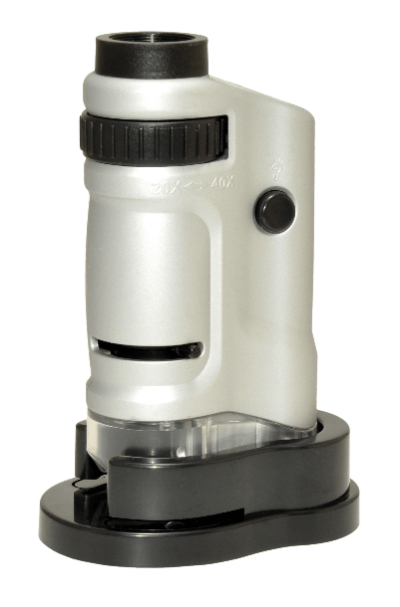What Is a Handy Scope?

A handy scope is a microscope that can be held by hand.
It is also called a hand-held microscope. It can project a magnified object on a screen such as a PC or monitor, allowing observation without looking through the lens as with a regular microscope.
Since the scope part can be held, it is possible to observe an object that cannot be observed on a stage by bringing the lens directly close to the object. For observation in more confined spaces, an endoscope-type product called a micro handy scope is used.
Uses of Handy Scopes
The uses of handy scopes are diverse. They are used in a wide range of fields because they can be easily angled with one hand for easy observation.
It can easily inspect cracks in pipes and tanks, dirt and clogged metal filters, and the inside of hard-to-reach spaces, machines, pipes, and ducts. The lightweight and one-handed operation makes it easy for anyone to work anywhere.
Principle of the Handy Scopes
A handy scope has a longer cable section than a typical microscope. A microscope is called a microscope in English, and a microscope and a microscope are the same thing. However, in Japan, the type with two lenses (an eyepiece and an objective lens) is called an optical microscope, while the type with one lens is called a microscope.
The magnification of an optical microscope is determined by the product of the magnification of the eyepiece and objective lens. On the other hand, the magnification of a handy scope is determined by the product of the magnification of the objective lens, the magnification of the digital camera, and the magnification of the monitor.
The structure of the handy scope does not allow for viewing with both eyes, as is the case with an optical microscope, making it difficult to see three-dimensional objects.
Structure of Handy Scopes
A handy scope consists mainly of an optical lens, a camera, and a light source lamp and cable. Cables are connected to dedicated information processing equipment, PCs, monitors, and other devices.
Some types of handheld scopes have auto-focusing (automatic focus adjustment function) and light intensity adjustment functions.
How to Select a Handy Scope
The requirements for a handy scope vary depending on the object to be observed, the frequency of use, and the required image quality.
1. Magnification
The magnification of the lens of a handy scope should be selected according to its purpose. There is a wide range of magnifications that can be used for observation, but the higher the magnification, the narrower the field of view and focal range, making it more difficult to find the object.
Especially at magnifications of 100x or more, it is difficult for human handlers to focus on an object, and this is where depth composite technology becomes necessary. Depth composite technology is a function that combines images in focus at multiple depths into a single image. When using high magnification, it is necessary to select a handy scope that is equipped with the depth composite function.
2. Focus Function
Handy scopes are handheld, which inevitably causes camera shake. Especially when magnification is high, even a small camera shake can cause a large shift in focus. Since it is cumbersome and burdensome to focus each time during work, a product with an auto-focus function is recommended when the magnification is high or when the scope is used for a long period.
3. Resolution
Since the handy scope is equipped with a camera, the number of pixels in the camera also affects the image quality. The larger the number of pixels and data, the more detail can be seen in the image, but care should be taken because the storage capacity becomes larger.